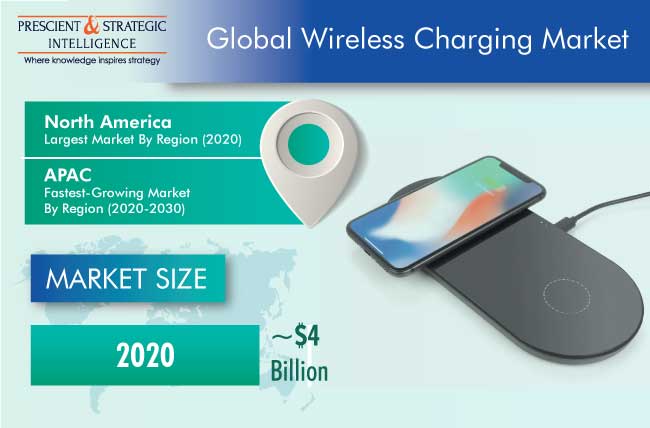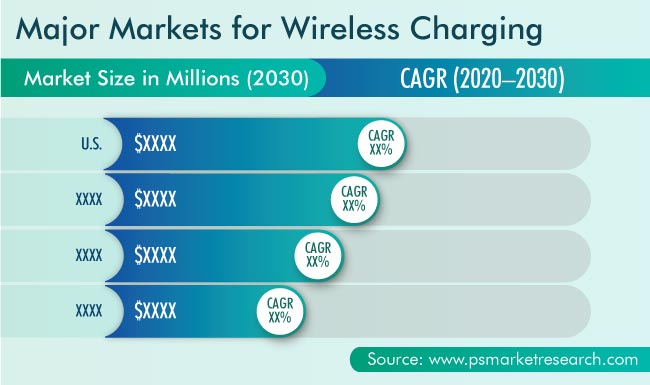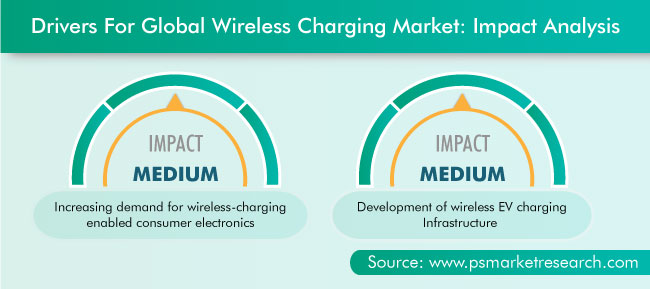Report Code: 12232 | Available Format: PDF
Wireless Charging Market Research Report: By Technology (Magnetic Resonance, Inductive, Radio Frequency), Component (Transmitters, Receivers), Application (Consumers Electronics, Healthcare, Automotive) - Global Industry Analysis and Growth Forecast to 2030
- Report Code: 12232
- Available Format: PDF
- Report Description
- Table of Contents
- Market Segmentation
- Request Free Sample
Market Overview
The global wireless charging market generated ~$4 billion revenue in 2020, and it is expected to grow at a significant rate during the forecast period (2021–2030). The major reasons responsible for the market's growth include an increase in the demand for wireless charging in smartphones, headphones, smartwatches, and other consumer electronics, deployment of wireless charging capabilities in medical equipment, and expansion of the electric vehicle (EV) industry.
The COVID-19 pandemic had a negative impact on the growth of the wireless charging market. The manufacturing plants of consumer electronics, medical devices, and EV companies halted their production, which slowed the growth of the wireless charging market. However, the market is expected to grow again after the COVID-19 crisis.

For its Efficiency, Inductive Charging is Most-Widely Used Technology
The inductive charging technology is most widely used by the wireless charging market players in their equipment, and it is expected to continue its domination during the forecast period. The technology is widely used in low-power devices, such as, smartphones, smartwatches, ear pods, and fitness bands, and it is also being increasingly adopted in medical appliances. With this technology, the users can place the device to be charged on a conductive pad that is directly connected to a wall socket.
Receivers Held Larger Market Share in 2020
The global wireless charging market has been categorized into transmitters and receivers, based on component. Of these, receivers held the larger market share in 2020, as many receivers are used to charge several devices from a single source. As such, for charging an EVs, there are more EVs than charging facilities. Wireless charging utilizes radio frequencies transmitted through a wireless charger and picked up by a receiver within the device, and they are then converted to DC voltage. Wireless power transfer does not depend on the alignment of the transmitter and receiver, thus providing users an easier charging experience.
Wireless Charging Being Adopted Rapidly in Consumer Electronics Industry
The global wireless charging market has been categorized into consumer electronics, healthcare, automotive, and others, based on application. Of these, consumer electronics, such as smartphones, tablets, wearable devices, laptops, MP3 players, gaming consoles, and personal digital assistance (PDAs), are being integrated with wireless charging. The increase in the demand for such wireless-charging products is propelling the wireless charging market.
North America To Have Largest Market Size during Forecast Period
Globally, the North American region will lead the wireless charging market till 2030 due to the presence of a large number of market players, including Qualcomm Technologies Inc, Energizer Holdings Inc., Plugless Power LLC, and WiTricity Corporation; rapid growth in the sales of consumer electronic products, and wireless charging innovations in the EV sector and medical devices, all of which have encouraged manufacturers to invest heavily in wireless charging.
Asia-Pacific (APAC) Region Shows Significant Growth due to its Huge Consumer Products Market
The APAC wireless charging market is growing due to the rising demand for EVs and consumer electronics, including, smartphones, smartwatches, ear pods, laptops, gaming consoles, and PDAs.

Market Expansion is being driven by Increasing Demand for Consumer Electronics
The strong demand for wireless charging in smartphones and various other consumer electronic devices, such as earphones and smartwatches, is one of the key drivers for the wireless charging industry. This technology has already been introduced by some consumer electronic companies; however, only in premium smartphones. As the demand for wireless-charging-enabled appliances steadily increases, the technology is expected to be used in various devices, such as drones, laptops, and handheld devices.

Rising EV Demand is Boosting Market Growth
Wireless charging is becoming more popular in the EV industry every year as it is being explored to replace the traditional method of connecting the vehicle to a power source with a cord. Wireless charging is being implemented in all-electric vehicles to reduce human involvement, which is helping in the growth of the wireless charging market. Wireless charging allows EVs to charge without any need for a plug. Many international organizations, such as the International Electro Technical Commission (IEC), Society of Automotive Engineers (SAE), Underwriters Laboratories (UL), and Institute of Electrical and Electronics Engineers (IEEE), are working on standards to improve the safety and efficiency of wireless EV charging systems.
| Report Attribute | Details |
Historical Years |
2015-2020 |
Forecast Years |
2021-2030 |
Base Year (2020) Market Size |
~$4 Billion |
Report Coverage |
Market Trends, Drivers, and Restraints; Revenue Estimation and Forecast; Segmentation Analysis; Regional and Country Breakdown; Impact of COVID-19; Companies’ Strategic Developments; Market Share Analysis; Company Profiling; |
Market Size by Segments |
By Technology; By Component; By Application; By Region |
Market Size of Geographies |
U.S.: Canada; Germany; France; Italy; U.K.; Spain; Japan; China, India; Australia; South Korea; Brazil; Mexico; Saudi Arabia; South Africa |
Secondary Sources and References (Partial List) |
International Electro Technical Commission (ICE), Federal Energy Regulatory Commission, Underwriters Laboratories (UL), Institute of Electrical and Electronics Engineers (IEEE) |
Explore more about this report - Request free sample
Market Players Involved in Product Launches and Collaborations to Gain Significant Position
Some of the major players in the market are Samsung Electronics Co. Ltd., WiTricity Corporation, Qualcomm Technologies Inc., Texas Instruments Inc., Integrated Device Technology Inc., Powermat Technologies Ltd., NXP Semiconductors N.V., TDK Corporation., and Convenient Power HK Limited.
In recent years, players in the wireless charging industry have been involved in collaborations and product launches in order to attain a significant position. For instance:
- In January 2021, Xiaomi Corporation introduced the Mi Air Charge technology, which enables users to remotely charge electronic devices without any cable or wireless charging stand. The Xiaomi remote charging technology is capable of 5-Watt remote charging for a single device within a radius of several meters. Apart from that, multiple devices can be charged at the same time.
- In December 2019, Integrated Device Technology Inc. and Qualcomm Inc. collaborated to use IDT’s integrated circuit (IC) for consumer electronics devices based on Qualcomm’s WiPower Technology. This IC is designed to meet the requirements of Qualcomm’s new near-field magnetic-resonance wireless power charging module, which is designed to provide spatial freedom for charging consumer electronics, such as mobile phones, and other battery-powered/low-power direct-charge devices.
Key Players in Wireless Charging Market Are:
-
Samsung Electronics Co. Ltd.
-
WiTricity Corporation
-
Qualcomm Inc.
-
Texas Instruments Inc.
-
Integrated Device Technology Inc.
-
Powermat Technologies Ltd.
-
NXP Semiconductors N.V.
-
TDK Corporation
-
Convenient Power HK Limited
Market Size Breakdown by Segments
The global wireless charging market report offers comprehensive market segmentation analysis along with market estimation for the period 2015-2030.
Based on Technology
- Magnetic Resonance
- Inductive
- Radio Frequency
Based on Component
- Transmitters
- Receivers
Based on Application
- Consumers Electronics
- Healthcare
- Automotive
Geographical Analysis
- North America
- U.S.
- Canada
- Europe
- Germany
- France
- U.K.
- Italy
- Spain
- Asia-Pacific (APAC)
- China
- Japan
- India
- Australia
- South Korea
- Latin America (LATAM)
- Brazil
- Mexico
- Middle East and Africa (MEA)
- Saudi Arabia
- South Africa
The global wireless charging market was valued at ~$4 billion in 2020.
The COVID-19 pandemic has negatively impacted the wireless charging industry.
North America will be the largest region in the wireless charging industry between 2021 and 2030.
The surging sales of consumer electronics is the major growth driver for the market for wireless charging.
The receivers category was larger in the component segment of the market for wireless charging systems in 2020.
Want a report tailored exactly to your business strategy?
Request CustomizationWant an insight-rich discussion with the report author?
Speak to AnalystOur dedication to providing the most-accurate market information has earned us verification by Dun & Bradstreet (D&B). We strive for quality checking of the highest level to enable data-driven decision making for you
Our insights into the minutest levels of the markets, including the latest trends and competitive landscape, give you all the answers you need to take your business to new heights
With 24/7 research support, we ensure that the wheels of your business never stop turning. Don’t let time stand in your way. Get all your queries answered with a simple phone call or email, as and when required
We take a cautious approach to protecting your personal and confidential information. Trust is the strongest bond that connects us and our clients, and trust we build by complying with all international and domestic data protection and privacy laws